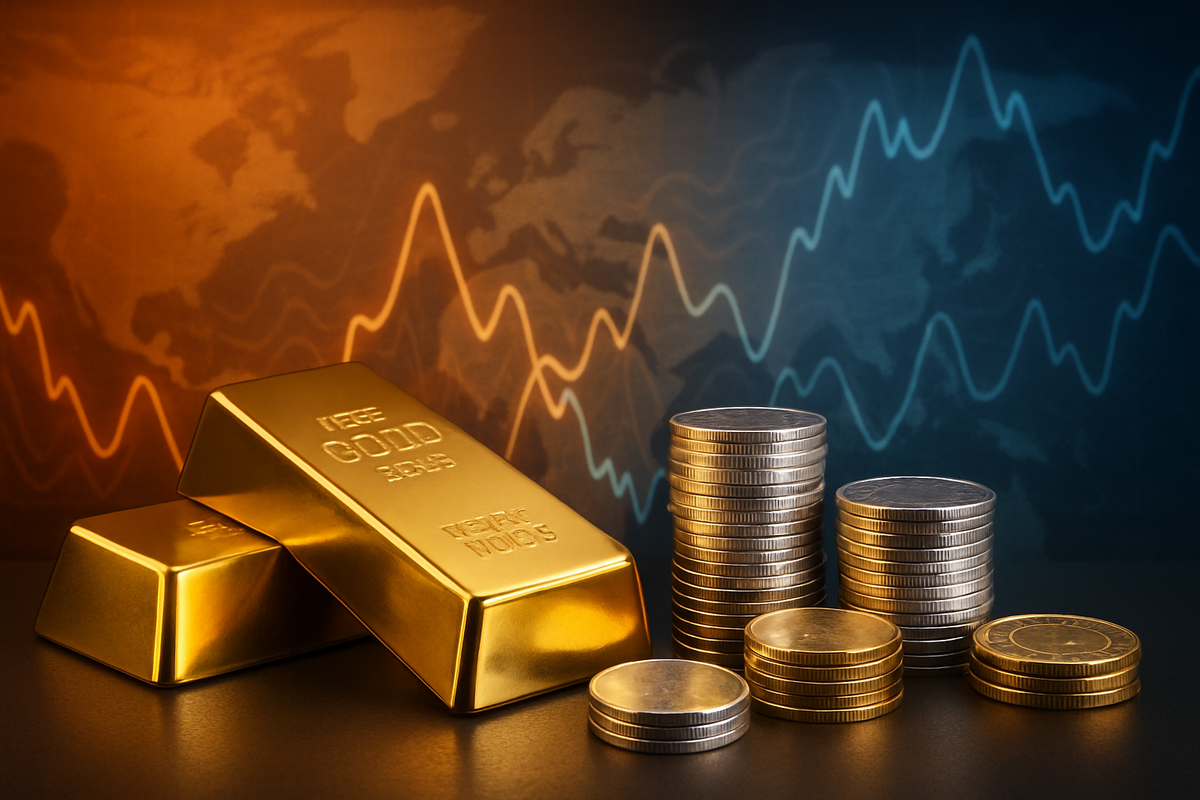
The global financial markets are currently witnessing a captivating display of volatility in the precious metals sector, as both gold and silver have experienced unprecedented rallies followed by sharp, albeit anticipated, corrections in late 2024 and throughout 2025. These dramatic price swings, driven by a complex tapestry of geopolitical tensions, shifting interest rate expectations, and robust industrial demand, have left investors both exhilarated by record highs and cautious in the face of sudden dips. As of October 22, 2025, the market is grappling with the immediate implications of these fluctuations, including heightened volatility and a re-evaluation of safe-haven asset strategies.
The recent corrections, particularly a notable dip around mid-October 2025, are largely being interpreted as "healthy" profit-taking after a historic bull run. However, they underscore the intricate balance of factors influencing these crucial commodities. While the long-term bullish outlook for gold and silver remains largely intact due to persistent inflation concerns, aggressive central bank accumulation, and robust industrial demand for silver, the short-term landscape demands careful navigation, offering both potential buying opportunities for strategic investors and a stern reminder of market liquidity dynamics.
Unpacking the Rollercoaster Ride: A Timeline of Precious Metal Movements
The journey of gold and silver prices over the past year has been nothing short of remarkable. Gold embarked on an extraordinary ascent, shattering previous records to surpass $2,800 per ounce in November 2024. This momentum continued unabated into 2025, with the yellow metal breaching the $3,000 mark by mid-March and ultimately soaring past $4,000 per ounce. A historic peak of approximately $4,398.00 per ounce was touched on October 20, 2025, marking a truly unprecedented run for the ancient store of value.
Silver, often considered gold's more volatile sibling, mirrored this impressive trajectory. It broke through a decade-long resistance level of $30 per ounce in 2024, reaching $35 before stabilizing around $32 by December 2024. The white metal's rally gained significant traction in 2025, pushing towards the $50 an ounce level and hitting a peak of $54.3775 per ounce around mid-October. Notably, silver's performance in 2024 even outpaced gold's strong showing, demonstrating its unique blend of safe-haven and industrial appeal.
However, the euphoria of these record highs was met with an abrupt reality check. Between October 17-22, 2025, both metals experienced a sharp correction. Gold recorded its steepest one-day decline since 2013, falling as much as 6.3% from its recent peak to $4,082.03 per ounce. Silver's dip was even more pronounced, with spot silver dropping 8.7% to $47.89 an ounce, marking its sharpest fall since February 2021. These significant declines, wiping hundreds of dollars off gold and several dollars off silver within hours, were primarily attributed to widespread profit-taking by investors after the metals became technically overbought. Other contributing factors included a strengthening U.S. dollar, perceived easing of geopolitical tensions, and a renewed "risk-on" sentiment in broader stock markets, temporarily diverting capital away from precious metals.
Corporate Fortunes: Winners and Losers in the Volatile Precious Metals Market
The recent dramatic swings in gold and silver prices have created a distinct landscape of winners and losers among public companies, particularly within the mining sector and related industries. Companies with robust production, efficient operations, and hedged positions are better equipped to navigate this volatility and capitalize on high price environments, while others might face increased operational costs or reduced profitability during dips.
Mining giants like Barrick Gold (NYSE: GOLD) and Newmont (NYSE: NEM), as primary producers of gold, have largely benefited from the sustained rally, especially when prices were consistently above $3,000 and even $4,000 per ounce. Higher gold prices translate directly into increased revenues and improved profit margins, allowing these companies to strengthen their balance sheets, invest in exploration and development, or return capital to shareholders. Similarly, companies with significant silver operations, such as Wheaton Precious Metals (NYSE: WPM), a streaming and royalty company, would have seen their asset values and royalty incomes surge during silver's ascent towards $50 an ounce. These companies often have lower operating costs relative to the selling price during bull markets, leading to substantial windfalls.
Conversely, while the overall trend has been positive, the sharp corrections, such as the one in mid-October 2025, can temporarily impact these companies. A sudden drop in prices can trigger a re-evaluation of future earnings projections and potentially lead to short-term stock price declines, even if the long-term outlook remains strong. Companies with less efficient operations, higher debt loads, or unhedged exposure to price fluctuations might feel the pinch more acutely during such downturns. Furthermore, the volatility itself can make long-term planning challenging, affecting decisions on capital expenditure and expansion projects. Beyond miners, industries relying on silver as an industrial input, such as solar panel manufacturers or electronics companies, might face increased raw material costs during sustained high silver prices, potentially impacting their profitability unless these costs can be passed on to consumers.
Broader Implications: Geopolitics, Inflation, and the De-Dollarization Trend
The recent volatility in gold and silver prices is not an isolated market phenomenon but rather a vivid reflection of deeper macroeconomic and geopolitical currents shaping the global financial landscape. The sustained rallies leading up to October 2025 were heavily underpinned by persistent geopolitical tensions, including ongoing conflicts and trade disputes, which consistently fueled safe-haven demand for both metals. In an environment of uncertainty, investors flock to assets perceived as stable stores of value, and gold and silver have historically fulfilled this role.
Furthermore, expectations of interest rate cuts by major central banks, particularly the U.S. Federal Reserve, made non-yielding assets like precious metals more attractive. When interest rates are low or falling, the opportunity cost of holding gold (which doesn't pay interest) decreases, enhancing its appeal. Coupled with lingering inflation concerns, precious metals served as a critical hedge against the erosion of purchasing power. A significant broader trend reinforcing gold's ascent has been the aggressive and consistent accumulation of gold by central banks globally, especially in emerging markets. This "de-dollarization" movement, aimed at diversifying national reserves away from the U.S. dollar, has provided a structural floor for gold prices and signals a long-term shift in global financial architecture.
Silver's dual role as both a monetary metal and a critical industrial commodity adds another layer of complexity. Robust demand from rapidly expanding sectors such as solar panels, electric vehicles (EVs), and 5G technology, combined with persistent supply deficits and declining inventories, has provided strong fundamental support for silver prices. This industrial demand component differentiates silver from gold and makes its price movements sensitive to global economic growth forecasts. Historically, sharp corrections in precious metals, like the one witnessed in October 2025, are often followed by periods of consolidation before resuming upward trends, especially when fundamental drivers remain intact. These events highlight the metals' sensitivity to shifts in investor sentiment and the U.S. dollar's strength, serving as a barometer for global economic confidence and risk appetite.
What Comes Next: Navigating the Future of Precious Metals
Looking ahead, the precious metals market is poised for continued dynamism, with both short-term fluctuations and long-term structural trends shaping its trajectory. In the immediate future, investors should anticipate ongoing volatility as the market digests recent gains and corrections. The "healthy correction" observed in mid-October 2025 is widely viewed by analysts as a potential buying opportunity for those looking to establish or increase their exposure to precious metals at more attractive price points. However, the exact timing and magnitude of future price movements will heavily depend on incoming economic data, particularly U.S. inflation reports, employment figures, and the forward guidance from central banks regarding monetary policy.
In the long term, the fundamental drivers supporting a bullish outlook for gold and silver remain robust. Persistent global inflation concerns, even if moderated, will continue to underscore the role of precious metals as a hedge against currency debasement. The ongoing trend of central bank gold accumulation, driven by geopolitical diversification strategies, provides a significant structural demand component that is unlikely to abate soon. For silver, its increasing indispensability in green technologies and electronics ensures sustained industrial demand, which, when combined with potential supply deficits, suggests a strong long-term growth trajectory. Companies in the mining sector may need to strategically pivot, focusing on cost efficiency and exploring new deposits to capitalize on potentially higher average prices over the coming years.
Potential scenarios include a gradual consolidation phase followed by renewed upward momentum if geopolitical tensions persist or inflation proves stickier than anticipated. Conversely, a significant de-escalation of global conflicts or a decisive shift towards aggressive monetary tightening by central banks could lead to further short-term price weakness. Market opportunities may emerge for investors who adopt a long-term perspective, focusing on dollar-cost averaging into positions during dips. Challenges include managing the inherent volatility and distinguishing between temporary corrections and more significant trend reversals. The interplay between physical demand, investment flows into ETFs, and speculative trading will continue to define the market's character.
A Golden and Silver Lining: Key Takeaways and Future Watchpoints
The recent extraordinary journey of gold and silver prices, marked by record-breaking rallies and sharp corrections, underscores the inherent volatility and profound significance of these precious metals in the global financial ecosystem. The period leading up to and including October 2025 has been a powerful demonstration of how a confluence of macroeconomic factors—such as geopolitical instability, inflation expectations, central bank policies, and industrial demand—can drive dramatic shifts in asset valuations. The key takeaway for investors is the dual nature of these commodities: offering safe-haven protection and growth potential, but also demanding resilience in the face of swift price adjustments.
Moving forward, the market for gold and silver is expected to remain dynamic. While the immediate corrections have provided a temporary breather and a chance for profit-taking, the underlying structural drivers that fueled their ascent are largely intact. The ongoing de-dollarization efforts by central banks, coupled with persistent global uncertainties and the increasing industrial application of silver, particularly in green technologies, paint a picture of continued long-term relevance and potential appreciation. Investors should view the recent dips as part of a natural market cycle, rather than a fundamental erosion of value, especially given the historical context of precious metals as hedges against systemic risks.
For the coming months, investors should closely monitor several key indicators. These include global inflation data, particularly from major economies, as sticky inflation will continue to bolster demand for precious metals. Central bank rhetoric and actual policy decisions regarding interest rates will be crucial, as dovish stances tend to support gold and silver. Geopolitical developments, especially those impacting global stability and trade relations, will also be significant catalysts. Finally, tracking industrial demand reports for silver, especially from the solar, EV, and electronics sectors, will provide insights into its unique growth drivers. A diversified portfolio approach, with a strategic allocation to precious metals, remains a prudent strategy for navigating the complexities of the evolving global financial landscape.
This content is intended for informational purposes only and is not financial advice








